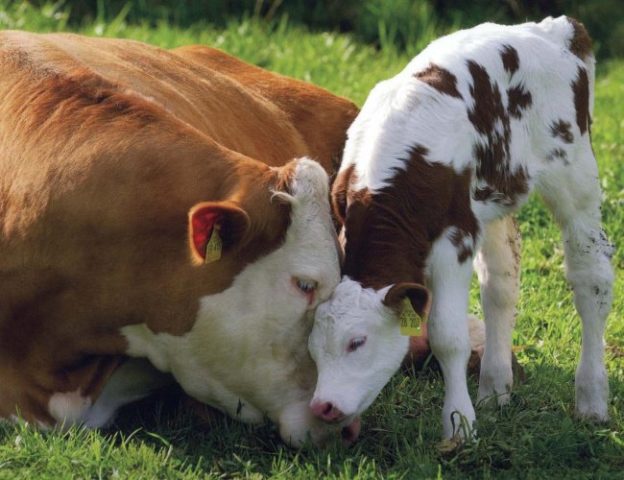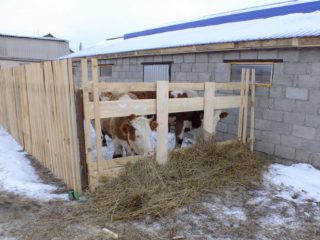Content
If all the symptoms are detected in time, and treatment of pneumonia in calves is carried out under the supervision of a specialist, then the animals will quickly return to normal, and without any negative consequences. At an advanced stage, pneumonia can become chronic and lead to serious disorders of the respiratory and digestive systems, which will inevitably affect the development of young animals.
Most often, pneumonia or pneumonia develops in calves under 5 months of age. Adults are less susceptible to this disease.
Causes of pneumonia in cattle
It is customary to identify the following reasons why young animals develop pneumonia:
- Unfavorable living conditions. If calves sleep on a cold, damp floor without bedding and are in a room that is rarely ventilated, the risk of pneumonia increases greatly.
- Stress after early weaning. It is not recommended to wean young calves from their mother's milk too early.
- Castration in young bulls.
- Poor quality feed or poor diet.In particular, calves often develop pneumonia during the transition from milk feeding to roughage, since any sudden change in diet weakens the animal's body.
- Illiterate transportation. Animals can catch a cold during transportation in the cold season.
- Lack of movement and oxygen deficiency due to rare walking. Without movement, the animals' muscles atrophy, as a result of which the ventilation of the lungs weakens.
- Viral and bacterial infections.
- Overheating in the sun, which causes disruption of thermoregulation.
- Keeping a large number of animals in cramped conditions. When a large number of cows and calves gather in one room, large amounts of ammonia and hydrogen sulfide quickly accumulate in the air, which does not have the best effect on the health of cattle.
Symptoms of pneumonia
The success of treatment largely depends on how early pneumonia is detected in cattle. The following changes in the behavior and well-being of animals indicate pneumonia in calves:
- rapid and difficult breathing;
- frequent cough;
- watery discharge from the nose and eyes;
- high body temperature;
- rare stools, diarrhea;
- lack of chewing gum;
- depressed state of the animal as a whole (lethargy, apathy, ears drooping).
Some symptoms alone do not always mean that the calf has pneumonia. Very often, coughing and slight nasal discharge are observed in individuals kept in a barn with musty air.In this case, it is enough to transfer the animals to another room or ensure regular ventilation of the previous place.
Course of the disease
The disease can occur in acute or chronic form. In particularly advanced cases, the course of the disease is accompanied by abundant formation of ulcers.
The acute form of pneumonia primarily involves a sharp increase in body temperature, coughing and discharge from the nose and eyes. The appetite and general condition of the animals are satisfactory, although apathy in the behavior of calves is sometimes observed. Sick animals do not move unless necessary and prefer to lie still. If the disease is started, its symptoms will begin to expand: the stool will change, the calves will begin to refuse food, etc.
The chronic course of pneumonia in cattle is characterized by a clear developmental delay:
- sick calves are smaller than their peers;
- there are bald spots and bald patches on the fur;
- dry skin.
Just as in the acute form, animals move little, cough and show constant shortness of breath. Occasionally, mucous nasal discharge can be observed in infected calves. The body temperature of sick calves is normal, which is one of the main differences between the chronic form of pneumonia and the acute form.
Diagnostics
A specialist must diagnose pneumonia in cattle - almost all symptoms of pneumonia, to one degree or another, overlap with some other diseases. In particular, when trying to determine the root of the problem on your own, it is very easy to confuse pneumonia with tuberculosis and dictyocaulosis. These diseases are treated in completely different ways.
In addition, before making a final diagnosis, the possibility of calves having the following diseases should be excluded:
- chlamydia;
- bronchitis;
- viral diarrhea.
The diagnosis is confirmed after laboratory tests. The best way to determine whether an animal's lungs are inflamed or not is to take a chest x-ray. Sometimes a lung biopsy is performed to make a definitive diagnosis.
Treatment methods
Before proceeding directly to the treatment of pneumonia in calves, it is necessary to isolate the animal and create the most comfortable living conditions for it. It is important that the sick individual is kept in peace and quiet, has access to fresh water, and the bedding in the stall is clean. Cattle nutrition is no less important - it would be a good idea to dilute the feed for calves with vitamin supplements. It is also recommended to take animals outside more often if the weather is dry and warm.
Drug treatment
All medications for the treatment of pneumonia are prescribed by a doctor. Under no circumstances should you attempt treatment yourself - any mistake can only worsen the condition of the infected calves.
In most cases, pneumonia is successfully treated with various antibiotics. They are represented by a wide variety, and the choice of a specific drug depends on the type of cattle (meat, dairy, meat and dairy), the age of sick individuals and the cause of the disease.
The most popular drugs for the treatment of pneumonia include the following drugs:
- "Cefazolin" is an antibiotic for intramuscular administration of the drug. It is highly recommended not to mix treatment with Cefazolin with other medications with strong effects.
- If the cough is dry, you can give the calves "Mukaltin", which quickly thins the mucus and helps remove it from the respiratory tract.
- Very often, “Isoniazid” is used to treat pneumonia in cattle, which is injected into the trachea.
In addition, the following medications are used to treat pneumonia, which are less common, however, they do a good job of the task:
- "Farmazin";
- "Tetracycline";
- "Streptomycin".
Additionally, the veterinarian may prescribe warming procedures, inhalations and rubbing. Novocaine blockade is good for pneumonia. In any case, the best results are obtained from complex treatment, when intravenous or intramuscular injections are combined with external influences on sick calves.
Traditional methods
Young calves are fed a soda solution, slightly warmed before use. In addition, the following herbs have proven themselves to be effective in treating pneumonia:
- thyme;
- liquorice root;
- coltsfoot.
Decoctions and infusions are made from these herbs, which are also aimed at stimulating the removal of phlegm.
Consequences
If treatment for pneumonia in cattle is started, it can become chronic or lead to serious disruptions in the functioning of the respiratory system. In addition, the cardiovascular and digestive systems, which are closely related to lung function, may be irreversibly damaged. Finally, if the animal suffers a severe illness, it can subsequently cause a general weakening of the immune system in calves. They will generally be more susceptible to unfavorable environmental conditions and various infectious diseases.
Pneumonia is extremely rarely fatal.
Prevention
Preventive measures against pneumonia in calves include compliance with the following recommendations:
- First of all, it is necessary to ensure good ventilation of the premises where calves are kept. For this purpose, a forced ventilation system is often installed in barns for convenience. In addition, calves with pneumonia need to be walked from time to time to prevent their muscles from atrophying.
- A good prevention against pneumonia is feeding small calves colostrum. They should receive the first portion within 3-5 hours after birth, the approximate volume is 3-4 liters. This natural food supplement activates the full functioning of the gastrointestinal tract on the first day of life and helps strengthen the immune system.
- Proper feeding alone reduces the risk of pneumonia in calves. A complete diet for calves should include milk feeding (5-7 liters per day) and free access to clean water. Starter feeds are introduced gradually so as not to stress the calves.
- In the barn, minimum sanitary requirements must be observed: the bedding must be changed in a timely manner, the premises and equipment themselves must be periodically disinfected.
Separately, it is worth highlighting such a method of prevention as vaccination. Currently, calves can be vaccinated against pneumonia using various drugs prescribed by a veterinarian. On the other hand, in addition to highly specialized vaccines, there are also complex ones that neutralize the effects of several types of bacteria at once.
Conclusion
The most important thing is to detect the first symptoms in time, and treating pneumonia in calves will take very little time. It is important to carefully monitor young animals in the first 2-3 months of life so as not to miss disturbances in the animals’ behavior. A healthy calf is active, its coat is smooth and shiny, and its stool is regular. He does not refuse food and drinks water often.If any deviations from these basic indicators are noticeable, you should take a closer look at the calf. Of course, only a veterinarian can make an accurate diagnosis - the symptoms of pneumonia largely overlap with other diseases, however, vigilance never hurts.
You can learn more about the treatment of pneumonia in calves from the video below:











